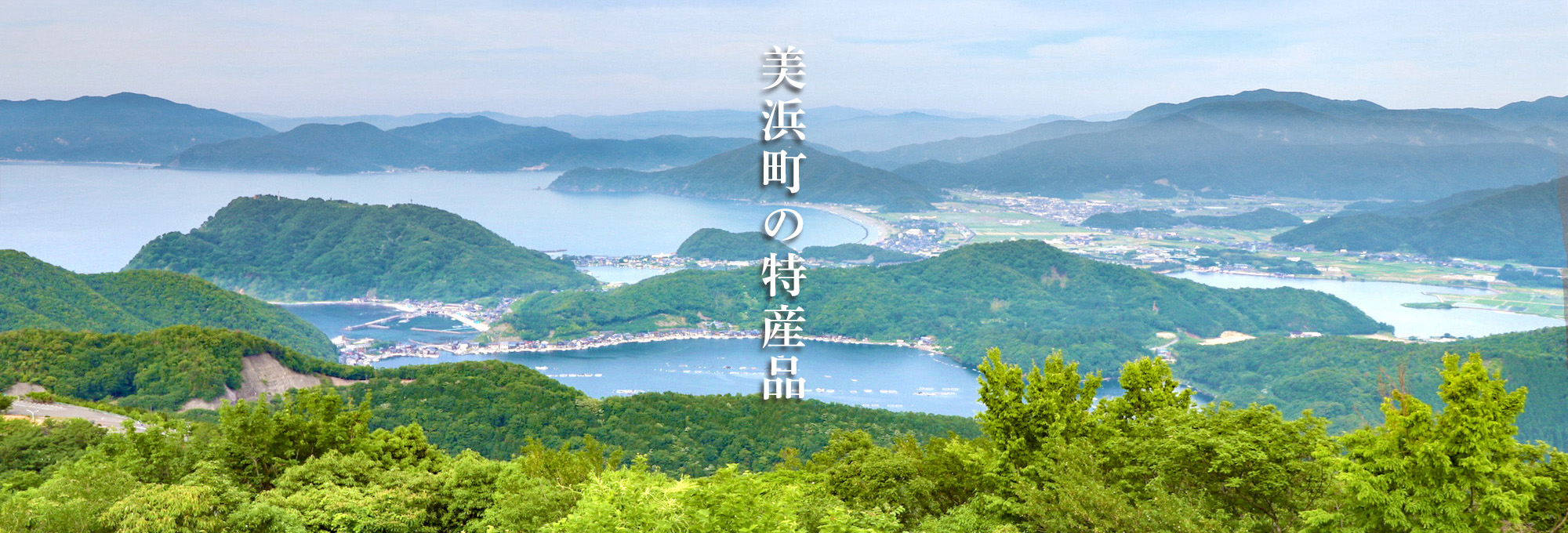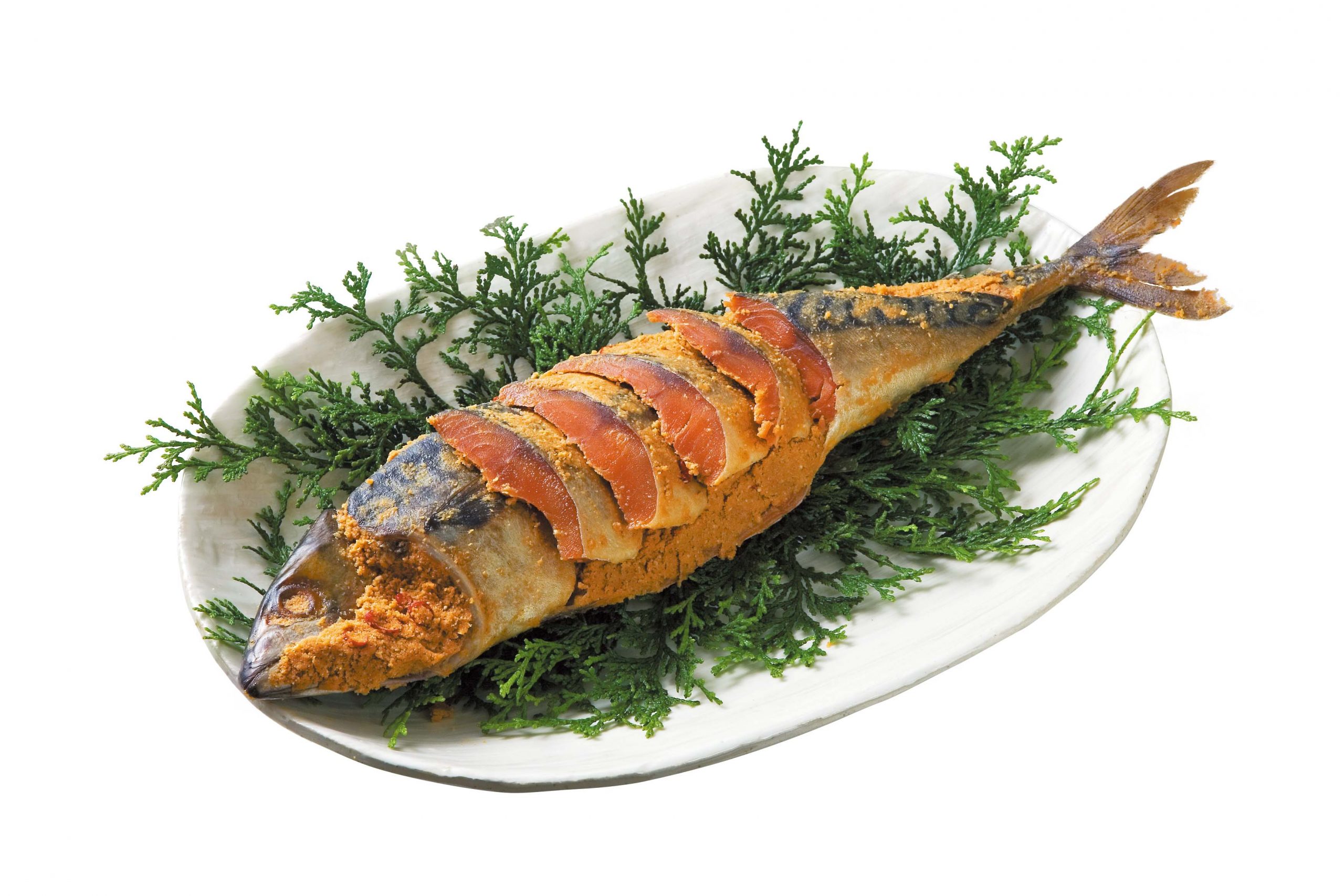
「へしこ」は鯖などの魚を塩漬けし、米糠に漬け込んで1年以上にわたり熟成させた発酵食品。樽に漬け込むことを「へし込む」と言っていたことから、「へしこ」の名前がついたと言われています。福井県若狭地方では、漁に出られない日が多い冬場の貴重なタンパク源として、昔から各家庭でつくられてきました。米糠に漬ける際には隠し味として、醤油やみりん、酒粕、唐辛子などを混ぜますが、その材料や配合は店や家によって異なるため、味や風味にも個性があります。出来上がったへしこは、そのまま食べる以外にも和洋さまざまな料理にアレンジしやすく、美浜町内のお店ではオリジナリティのあるへしこ料理をいただくことができます。美浜町では、長年親しまれてきたへしこをまちの伝統食として後世に伝えていこうと、2005年5月に「へしこの町」として商標登録。“へしこの町・美浜”の魅力あを県内外で発信する観光PRキャラクター「へしこちゃん」も誕生しました。さらに2007年12月には農林水産省から発表された「日本の郷土料理百選」にも選ばれるなど、へしこの人気・知名度は全国的に高まっています。
「Heshiko」是將鯖魚等首先用鹽醃製、然後米糠醃製1年以上的熟成發酵食品。放入樽內醃製這個動作稱為「heshikomu(醃製)」、因此才會成為「heshiko」。福井縣若狭地區、每到冬天就無法出海捕魚之故因此保存很多蛋白質來源的小巧思、其實從以前很多家庭就會製作。在用米糠醃製時會加入一些提味用調味料、醬油以及味琳、酒粕、辣椒等混再一起、使用的材料跟配方比也會依每個家庭會有所差異、因此在味覺跟風味上都會有各家的特色。完成的heshiko、除了直接吃以外也可以搭配日式洋式各種食材展現出不同的料理、美浜町内的店家都可以品嚐獨特的heshiko料理。美浜町裡、長年來受到老一輩親愛的heshiko的傳統食品為了能傳承後世、在2005年5月進行了「heshiko的家」商標登錄。同時“heshiko的家・美浜”的魅力透過縣內縣外的觀光宣傳人物角色「heshiko將」也誕生。另外在2007年12月農林水產省發表「日本的郷土料理百選」中也被選上、因此heshiko的人氣以及知名度全國性的提升了起來。
Heshiko is a fermented food aged for more than a year after salting down fish, such as mackerel , and then pickled in rice bran. The act ‘to pickle in a butt’ was called ‘heshi-komu’, which is said to have led to the name “heshiko.” In the Fukui Prefecture Wakasa area , heshiko had been made at home as a valuable source of protein when days you can’t go fishing become more frequent in the winter. As a hidden flavor , soy sauce, sweet sake, sake lees, red pepper, etc. are mixed when you pickle the fish with rice bran. The ingredients and amount differ by each restaurant and home, which makes each flavor and savor so original. The completed heshiko can be served as it is, or easily arranged to all sorts of Japanese and Western dishes. In Mihama-cho’s restaurant, you can enjoy many original heshiko dishes.
In May 2005, in the aim to convey the long-loved heshiko as its traditional food to the future generation, Mihama-cho registered the trademark “The Town of Heshiko. tourism PR character “Heshiko-chan” was also born to spread the charms of “the Town of Heshiko” to both the inside and outside of Fukui Prefecture. Furthermore, heshiko was elected as one of Japan’s 100 Best Country Dishes by the Ministry of Agriculture, Forestry and Fisheries in December 2007 and its popularity is increasing nationwide.
塩分控えめ健康食品! 少鹽的健康食品! Low salted healthy food!
へしこは本来はかなり塩辛いものでしたが、美浜町では旅館や民宿の女将たちが中心となり、気軽に食べてもらえるよう、味の改善を行ってきました。美浜町のへしこは塩分を減らし、じっくり熟成させているので味がまろやか。血圧抑制に効果があるとの研究結果も報告されるなど、健康食品としての効果も期待されています。
Heshiko本身就是稍微帶有鹹度、美浜町裡面以旅館及民宿的女將們為中心、已可以隨時食用為準則進行口味的改良。美浜町的heshiko是少鹽的、透過時間讓其熟成因此味道較為柔和。研究報告中也顯示具有抑制血壓的效果等、今後相當期待可以成為健康食品之一。
Originally, heshiko was a very salty food but in Mihama-cho, the landladies of Minshuku and ryokan took lead in improving the taste so that it can be eaten more casually. As Mihama-cho’s heshiko is salt-reduced and aged deliberately. it has a smooth taste. Researches on blood pressure control habe beeen reported on heshiko and its effects as a health food are expected as well.
米ヌカってなに? 什麼是米糠? What is rice bran?
米ヌカとは、玄米を精米するときに出る外皮や胚の粉のこと。日本では白米を食べるようになった江戸時代の頃から、ヌカ漬けや米ヌカ油として利用されてきました。米ヌカにはビタミンやミネラル、食物繊維、身体の毒素を排出するフィチン酸などが豊富に含まれており、美肌や便秘解消に効果があると言われています。
米糠是玄米在礦米時的外皮及胚粉.日本在開始食用白米的江戸時代左右起,把它使用在醃製品及米糠油.米糠含有維他命及礦物質,食物繊維,幫助身體排出毒素的肌醇六磷酸等豊富的水分,因此具有美肌及消除便秘的効果.
Rice bran is the rice hull and embryo powder that are discharged when you polish brown rice. In Japan, rice bran started to be used in rice bran pickles and as rice bran oil in the Edo Period. Rice bran is rich in vitamins and minerals, dietary fibers and phytic acid which discharges body toxins. It is said to be effective for beautiful skin and elimination of constipation.
ヌカ漬けによる作用 米糠醃製的作用 Actions by rice bran pickles
さまざまな成分が含まれている米ヌカに塩や魚から出る水分が加わることで、乳酸菌や酵母が増大。免疫力の強化や整腸作用、美肌や血圧抑制にも効果があると言われています。
含有各種成分的米糠加上醃製時的鹽巴以及魚所釋放出來的水分後,會増加乳酸菌及酵母.可以増免疫力及整腸作用,還有美肌踉抑制血壓的効果.
Lactic acid bacterium and yeast increase when salt and moisture from the fish are added to the rice bran paste full of various ingredients. It is said to be effective for immunity strengthening, intestinal action, beautiful skin and blood pressure control.
旨みが凝縮されたヌカ 凝縮甜味的米糠 Rice bran with condensed umami
へしこについた米ヌカ、そのまま捨てていませんか?米ヌカにはへしこのうまみが凝縮され、栄養満点!米ヌカを軽く炒ってごはんにかけたり、お茶漬けにするもよし。パスタに入れても相性抜群です。米ヌカのまろやかな塩気が野菜や肉の味を引き立てるので、ぜひいろんな料理に取り入れてみてください。
Heshiko外面的米糠你是不是把它丟掉呢?這個米糠千萬不可以丟棄,因為是凝縮heshiko的甜味所以營養滿分!這個米糠可以清妙一下拿夾拌飯吃或是茶泡飯.跟義大利麵一起拌著吃風味也很棒.米糠醇厚的鹽味可以提味蔬菜加肉,下次不妨也試試更多不同的料理吧.
Are you throwing away the rice bran covering heshiko? Wait, the rice bran has condensed umami and is full of nutritions! You can lightly roast the rice bran and sprinkle to rice or try it as tea on rice. It tasted great with pasta too. The mild saltiness of the rice bran brings out the taste of vegetables and meat, so please use it in all sorts of cooking.
美浜の風土から生まれた冬の保存食 Winter’s nonperishable food born from Mihama’s natural features
へしこの歴史は長く、江戸時代の中頃にはすでにへしこ作りが始まっていたと言われています。日本海に面した美浜町は漁業が盛んですが、冬は厳しく、荒波や積雪の日は漁に出ることもできません。そんな環境でタンパク源を取り入れるために生まれたのが、美浜のへしこ。各家庭の保存食として大変重宝され、珍味としてではなく日々の食卓料理として愛されるようになったのです。
Heshiko has along history and it is said that heshiko-making has already started in tihe mid-Edo era. Facing the Sea of Japan, the fishing industry is flourishing in Mihama-cho. However, the wintere is severe and you cannot possibly go fishing when the sea is rouhg or when the snow is deep. Mihama’s heshiko was born to take in protein in such environment. It was very much valued as a nonprishable food at each home and became loved not just as a dainty but as a daily dish on the table.
塩辛いヌカ漬けではない美浜のへしこ Mihama’s heshiko is no salty Nuka-zuke(rice bran pikles)
へしこと聞くと、塩辛いものを想像される方も多いと思いますが、美浜のへしこはとてもマイルド。塩とヌカだけを使う地域もありますが、美浜のへしこは醤油やみりん、唐辛子などをプレゼントした秘伝の調味料を本漬けの際に加えるので、小さい子どもからお年寄りまで味わえる食卓の一品となるのです。調味料は家庭によって異なり、代々続くおふくろの味が受け継がれています。
When you hear the word ‘heshiko,’ many of you might imagine something salty, however, Mihama’s heshiko in fact tastes very mild. there are regions where they only use salt and rice bran but here in Mihama we add a secret seasoning blended with soy sauce, sweet sake, red pepper, etc. in the main picking so that the heshiko becomes a dish on the table that a small child to an elderly can all enjoy. The seasoning differs from home to home and the taste of mother’s home cooking is handed down from generation to generation.
絶妙なバランスで成り立つ、へしこの栄養素 Nutrients of heshiko consist on a superb balance!
塩分を気にされる方は、へしこを避けてしまいそうですが、実はとても体に良い健康食品なのです!
まず、青魚の代表格である「鯖」。鯖の健康効果は近年注目されていますが、脳を活性化させる「DHA」が多く含まれています。DHAは認知症の予防や生活習慣病の緩和など、現代人にとって重要な栄養素のひとつ。これだけでなく、他にも多くの栄養素が含まれており、血液サラサラ効果・歯や骨の発育といった効果も期待されます。また、へしこ作りの過程で重要な「発酵」。これより、アミノ酸が結合した「ペプチド」がなんと生の鯖より5倍アップする研究結果が出ているんだとか!ペプチドは糖尿病の改善やシミ・そばかすの除去はもちろん、血液抑制効果を期待できる魅力の栄養素。それに加え、「ヌカ」に含まれるビタミンやミネラルは美肌や便秘解消にも効く女性の味方。これぞまさしく、健康も美容も兼ね備えた最強のスローフード!
People who care about salinith midht avoid heshiko but in fact it is a very healthy food! First of all, “mackerel,” the representative of bluebacks. The health effects of mackerel have been receiving a lot of attention these yoars. It contatins alot of ‘DHA’ that activates the brain. DHA is on of the most important nutrients for people of today as it prevents dementia and relieves lifestyle diseases and so on. Not just this DHA but mackerel also contains numberous nutrients and their effects of fluent and clean blood and tooth and bone growth are expected as well. Further, the “fermentation” that is important in the heshiko-making pprocess. Research results say that this increases “peptide,” combined amino acids, 5 times more than a raw mackerel. Not only does peptide improves diabetes, but it also removes stains and freckles, controls blood pressure and is a very attractive nutrient. In addition, the vitamins and minerals included in the ‘rice bran’ are effective fore beautiful skin and for relieving constipation and good for women. This is no doubt the greatest slow food for helth and beauty!
へしこができるまで 醃製鯖魚完成為止的作業流程 Steps to make heshiko
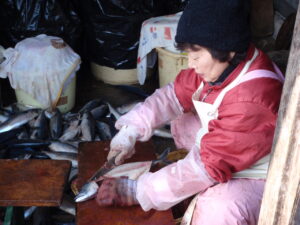
1.さばく 處理/cut and trim
魚の内臓をきれいに取り除き、腹と表面に塩を振ります。
取乾淨魚的内臓、在魚腹和表面撒鹽。
Thoroughly remove internal organs and sprinkle salt in the stomach and surface.
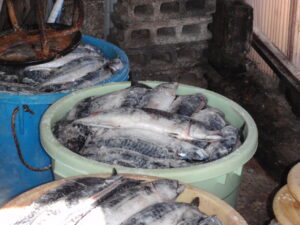
2.塩漬け 醃鹽/Preserve with salt
塩を振った魚を樽に1~2週間漬け込み、体内から出た水分を取り出します。
撒上鹽後的魚放入樽中1~2週、取出魚體内的水分。
Pickle the salted fish in the butt for 1-2 weeks. Remove any water discharged from the body.
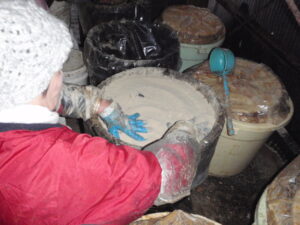
3.本漬け 正式醃製/Main pickling
塩を取り除き、醤油などで下味をつけ、糠をまぶしながら調味料を加えます。再び樽の中に重ね入れ上から重石をして寝かせます。
取出鹽分、加入醤油等調味料後、撒上糠再加入調味料。再把牠堆疊的放回樽中從上放上重石。
Remove the salt, season with soy sauce and other ingredients and then cover with rice bran and seasonings. Place the fish once again in the butt and place a stone as a weight on top and ferment.
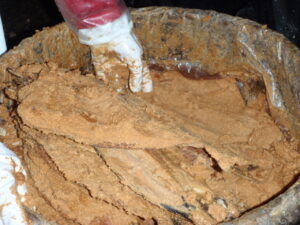 4.樽あげ 起樽/’Taru age'(Take out from butt)
4.樽あげ 起樽/’Taru age'(Take out from butt)
本漬けから一夏を越し、6か月から1年程度がすぎると食べ頃を迎えます。糠の中から丁寧にへしこをとりだし完成です。
正式醃製到過了一個夏天、6個月到1年左右的時間就是可以食用的時間。從糠中小心翼翼的取出醃製鯖魚後就大功告成了。
When one summer is over, approximately 6 to 12 months from the main pickling, the heshiko is ready to eat.
へしこの食べ方
【 焼きへしこ 】
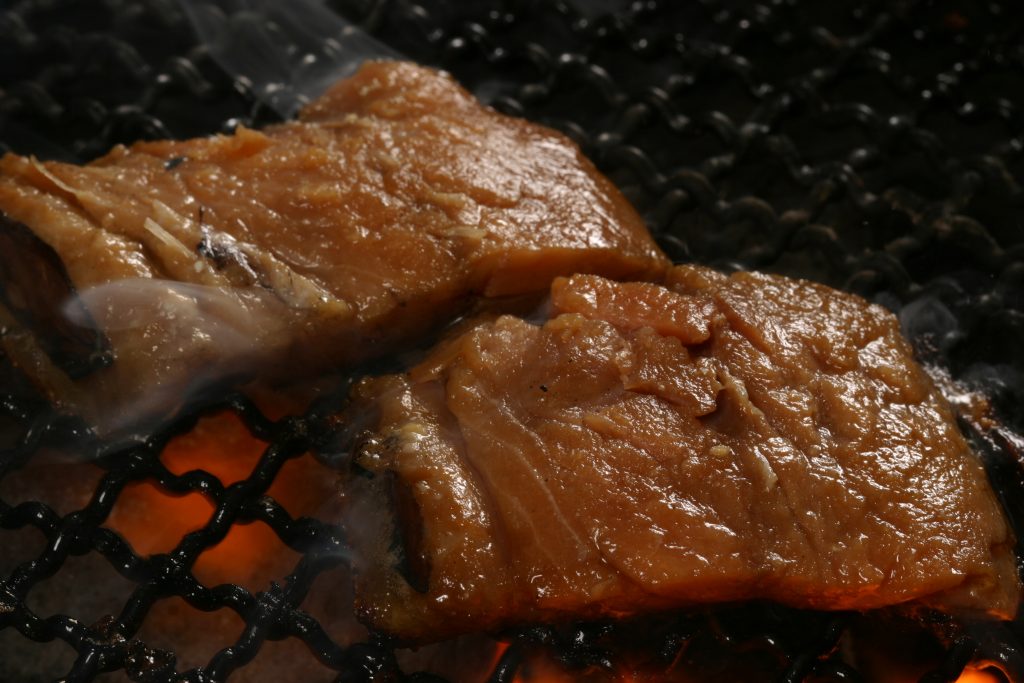
へしこについている米ぬかを軽く落とし、シンプルに焼いていただきます。ごはんのおかずやお酒のおつまみとして、簡単で最高においしい、オススメの食べ方です。焼いたへしこを細かくほぐし、ごはんにかけても美味しくいただけます。
【 お茶漬けと一緒に 】
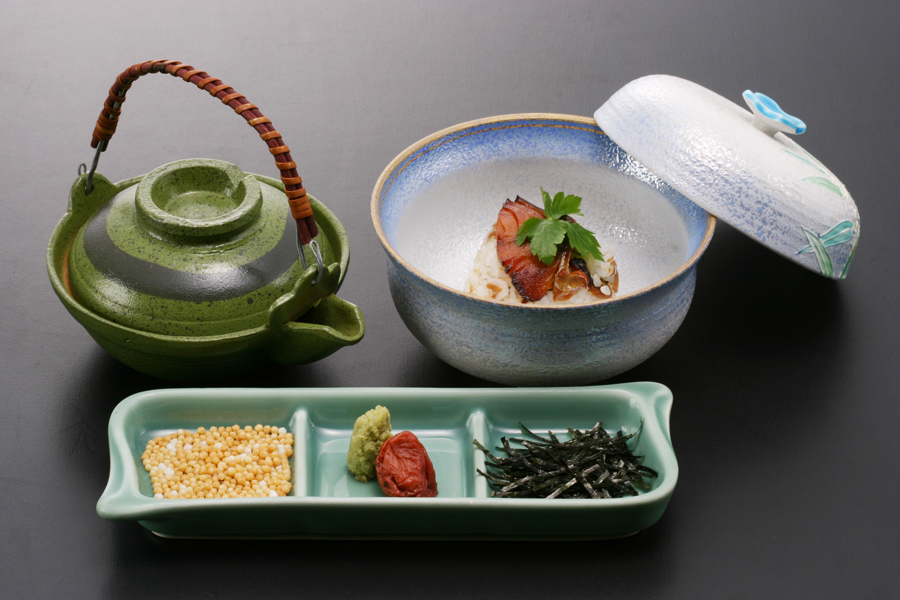
シンプルに焼いたへしこのお茶漬けもオススメの食べ方です。塩味が効いたへしこに温かいお茶を注ぐことで、味がマイルドになり、ゴマや梅干し、海苔やワサビのトッピングを加え、味の変化を楽みながらいただける一品です。
【 へしこのお刺身 】
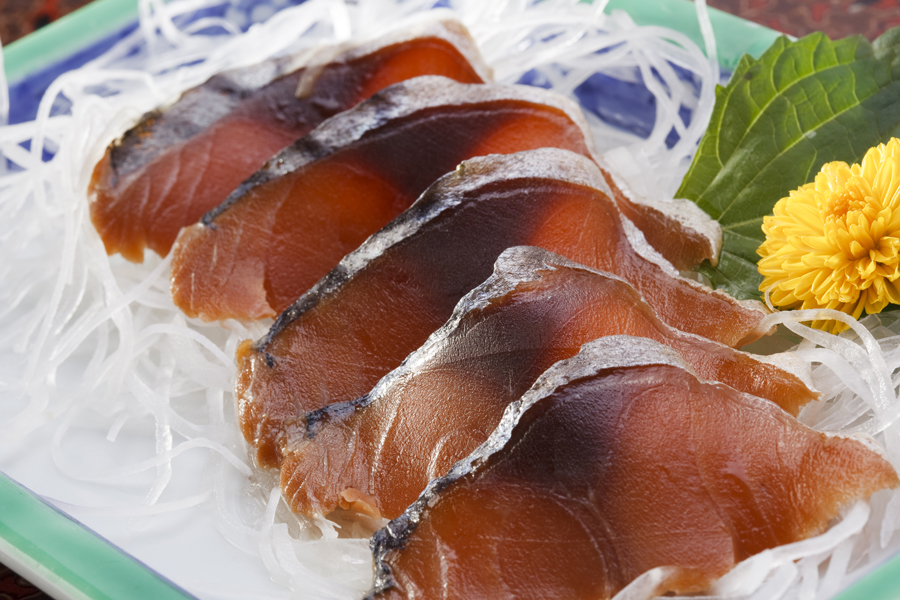
へしこについた「ぬか」を洗って水気をふき取り、薄く切って刺身としてもいただけます。焼かずに生で食べることで、鯖の熟成された味がより引きたち、焼きへしことはまた違った味を楽しめます。薄くスライスした大根を添えて一緒にいただくと絶品です。
へしこを使ったオリジナル料理の紹介

